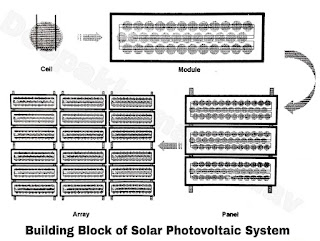Solar Photovoltaic Systems
The complete solar photovoltaic system is as shown in Figure A.
 |
| Figure A |
The major components of the system are as follows :
- Photovoltaic array
- Inverter
- Energy Storage
- System Charge Control
- Balance of System (BOC) Components
1. Photovoltaic Array :
The basic component is the solar cell. This is the device which generates electricity when exposed to light. A typical silicon cell can produce upto 0.5 V and upto 6 Amp i.e. it is equivalent to about 3 W powers. A number of cells are combined to form a Module. When modules are combined we get a Panel. Panels are combined to get an array. This is shown in Figure B.
 |
| Figure B |
This is a device that is used to change the voltage level or wave form or both. This is also called a power processing unit. The inverter converts a DC input to AC output. When such inverters are used in large grid connected system, special devices such as transformers have to be installed for converting the output voltage and frequency as per the standard norms. These are not required in case of standalone system. The protective device fitted on to the inverter ensures that :
- Automatically switch off If the array voltage is too high.
- Automatically restart when the voltage comes down to the normal value.
- Protect against short circuiting and overloading.
3. Energy Storage :
Storage batteries are used for storage of the solar energy. They are the most vital components of the SPV system. They are very essential to cater for the variations in the solar energy received and also the hours of no sunshine. The success of the SPV system depends to a great extend on the storage system. The main qualities required in batteries for use in SPV system are :
- Ability to withstand several charge discharge
- Low self discharge rate.
- Need very little or no maintenance.
1. Battery capacity :
Capacity of a battery is the total amount of electrical energy in can store. It is specified in AH (Ampere Hours). Thus, a 65 AH battery can supply current at the mute of 1 Amp for Hours or 65 Amp for 1 Hour. This will discharge the battery completely . But a battery Bould not be discharged fully. Generally discharge should be stopped at 70% of the capacity Capacity of the battery is affected by temperature. Approximately there is a reduction of 0.6% for every “Crise in temperature above 25°C. Once discharged batteries should not be left scharged for too long. With increase in depth of discharge the charge/discharge reduces drastically.
2. Types of Batteries :
(i) Lead Acid Batteries : These are very commonly used. They consist of 2 V cells. When fully charged the positive electrode is a plate of lead oxide and the negative is spongy lead. The electrolyte is dilute sulphuric acid. During discharge both plates get converted to lead sulphate. The specific gravity of sulphuric acid reduces. When it reaches 1.15, discharge should be stopped.
For charging current is passed through the battery in the reverse direction. This converts the electrodes back to its initial condition and the specific gravity of sulphuric acid increases. Charging should be stopped when the specific gravity reaches 1.25.
(ii) Nickel Cadmium Batteries : These are much costly compared to Lead Acid Batteries. The electrodes are :
- Positive – Nickel packed with Nickel Hydroxide
- Negative – Cadmium Immersed in Aqueous Potassium Hydroxide
The advantages of these are :
- No need for electrolyte-no spilling and freezing.
- Less sensitive to temperature.
- Less sensitive to rate of discharge.
- Battery can remain discharged for long without charging.
4. System Charge Control (Battery Controllers) : These are devices to ensure that the charging discharging of batteries are done within the prescribed limits.
It ensures that :
- Overcharging of the batteries is avoided. This avoids loss of electrolyte, corrosion and plate growth.
- Avoids repeated failures to reach full charge which may lead to damage to electrolyte.
- It ensures that charging is started with high current and as charging proceeds current gradually reduced. This is done by constantly monitoring the battery current, voltage and temperature.
5. Balance of Systems and Components :
These include all other equipments and components required to control, conduct, protez and distribute power in the system. They play a vital role in keeping the system in proper working condition, utilization of energy and ensuring safety of the devices. They help maximizing the output and protection of the components. Some of these are described below
- Blocking Diode : The SPV arrays are connected to the battery. During sunshine boun the panels generate electricity which charges the battery. But when there is no sunshine or during night the current will try to flow in the reverse direction i.e. from the battery the arrays. This can damage the arrays. So to avoid this reverse flow blocking diodes are used. They prevent the back flow.
- Voltage Regulator : The voltage output from the PV panels varies depending upon the intensity of light from sun. This would lead to fluctuation of load current. Voltage regulators will ensure that the voltage fluctuations are kept within the acceptable value.

